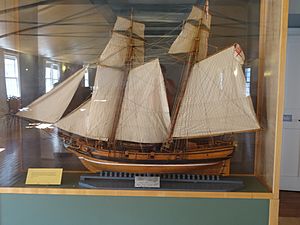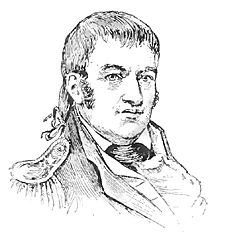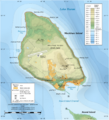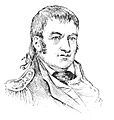Battle of Mackinac Island (1814) facts for kids
Quick facts for kids Battle of Mackinac Island |
|||||||
|---|---|---|---|---|---|---|---|
| Part of the War of 1812 | |||||||
 Topographic map of Mackinac Island. Crossed swords pinpoint the location of the battle in 1814 |
|||||||
|
|||||||
| Belligerents | |||||||
Native Americans |
|||||||
| Commanders and leaders | |||||||
| Robert McDouall Robert Dickson |
George Croghan, Andrew Holmes† Arthur Sinclair |
||||||
| Strength | |||||||
| 150 Native Americans, 140 regulars, 25 militia (untrained) |
700 | ||||||
| Casualties and losses | |||||||
| 1 dead, 1 wounded |
13 dead, 55 wounded |
||||||
The Battle of Mackinac Island (say it: Mack-in-aw) was an important fight during the War of 1812. It was a victory for the British and their Native American allies.
Before the war, Fort Mackinac was a key American trading spot. It was located in the Straits of Mackinac, between Lake Michigan and Lake Huron. This fort was very important for controlling trade and keeping good relations with the Native American tribes nearby.
Early in the war, a small group of British, Canadian, and Native American fighters captured the island. In 1814, the Americans tried to take it back. However, their plans were discovered. The British forces on the island were ready for them. When the Americans landed, they were surprised by Native American warriors. This forced the Americans to retreat with many injured soldiers.
Contents
Why Mackinac Island Was Important
Mackinac Island was a very important place for the North American fur trade. This trade was a huge part of life for Native American nations in the area. Most Native Americans did not want the United States to expand into their lands.
In July 1812, British soldiers, Canadian traders, and Native Americans captured Mackinac Island. They did this before the Americans even knew that war had started! This victory made many more Native tribes join the British side.
The British held Mackinac Island securely for a long time. This was because they also controlled Detroit. The Americans had to get Detroit back first. In September 1813, the Americans won a big naval battle on Lake Erie. This allowed them to take back Detroit. They also defeated the British and Native forces at the Battle of the Thames.
Even though it was too late to attack Mackinac before winter, the Americans had cut off British supplies. The British soldiers on Mackinac Island faced severe shortages of food.
British Get Ready for Battle
In 1814, Lieutenant Colonel Robert McDouall was sent to take charge of Mackinac Island. His first job was to open a new supply route. This new route went from York (now Toronto) to Georgian Bay.

McDouall brought 90 soldiers, 11 artillerymen, and 4 cannons. He also brought 21 sailors for the schooner Nancy. This ship was very important for carrying supplies. He also had 30 carpenters to build boats.
McDouall arrived at Mackinac on May 18, bringing much-needed food. A few days later, 200 more Native American allies joined him.
McDouall ordered the island's defenses to be made stronger. The old fort was on a ridge overlooking the harbor. But another higher ridge overlooked the fort itself. In 1812, the British had used this higher ridge to capture the fort. McDouall's troops built a new fort there. They called it Fort George.
American Plans to Attack

In 1814, the Americans planned to take back Mackinac Island. This was part of a bigger plan to stop the fur trade alliance between the British and Native Americans. The U.S. Navy Secretary, William Jones, supported the attack. It would give the American ships on Lake Erie something important to do.
The American attack force gathered at Detroit. Brigadier General Duncan McArthur set up Fort Gratiot at the end of Lake Huron. This was a forward base for the attack.
On July 3, an American fleet of five ships sailed from Detroit. They carried 700 soldiers led by Lieutenant Colonel George Croghan. The force included regular infantry soldiers and volunteers.
Instead of going straight to Mackinac, the American ships first searched for the British supply base. They thought it was at Penetanguishene. But they couldn't find it. They then sailed to St. Joseph Island, which had been a British military post. They found it empty and burned it. They also burned a Canadian trading post at Sault Sainte Marie.
The Americans finally arrived at Mackinac on July 26. Their delays had given McDouall plenty of warning. He had called in more militia to strengthen his defenses.
The Battle Begins
The American ships tried to bombard the fort for two days. But most of their cannonballs landed harmlessly. The new British blockhouse, Fort George, was too high for the ships' guns to reach. Thick fog then forced the American ships away for a week.
When they returned, Croghan decided to land on the north side of the island on August 4. This was near where the British had landed in 1812. He planned to march through the woods to attack the blockhouse. The American ships fired into the woods to scare away any Native Americans. This meant they lost any chance of surprising the British.
McDouall did not wait to be attacked. He left only 25 militiamen in Fort Mackinac and 25 in the blockhouse. He then advanced with his main force. They took positions behind low walls facing a clearing. This clearing was on the Americans' path. His force included 140 soldiers and 150 Menominee warriors.
When the Americans came out of the woods into the clearing, they were easy targets for the British cannons. Croghan brought up his own cannons. He also sent his Ohio Volunteers to attack the British left side. He sent his regular soldiers through the woods around the British right side. These movements were very slow because of the difficult land.
During this time, the American regulars were ambushed by Native Americans. Thirteen Americans were killed, including Major Holmes. Fifty-one were wounded. The Americans were thrown into confusion. McDouall then moved his soldiers back into their positions.
The heavy losses and confusion among the Americans forced Croghan to order a retreat. His men went back through the woods to the beach. Two wounded Americans were left behind and captured. The Americans rowed back to their ships. The fort remained in British hands until the end of the war.
What Happened Next
The American expedition later found the British post at the Nottawasaga River. On August 15, they captured it. The British sank their schooner Nancy so it wouldn't fall into American hands.
Commodore Sinclair left two gunboats, USS Tigress and USS Scorpion, to blockade Mackinac. He hoped to starve the British soldiers into surrendering. But in the Engagement on Lake Huron, both American ships were captured by the British. This secured British control of the whole region.
Legacy
Today, the Royal Newfoundland Regiment carries on the history of the Royal Newfoundland Fencibles. They earned a Battle Honour for their part in the "Defence of Canada 1812-1815," which includes the Battle of Mackinac Island.
Most of the battle site is now the Wawashkamo Golf Links. It was built in 1898.
Images for kids
-
In May 1814, 21 sailors from the Royal Navy arrived to reinforce the crew of HMS Nancy, a schooner vital to resupplying Fort Mackinac.
-
American Brig Gen Duncan McArthur established Fort Gratiot in 1814 as an advanced base to retake Mackinac Island.






